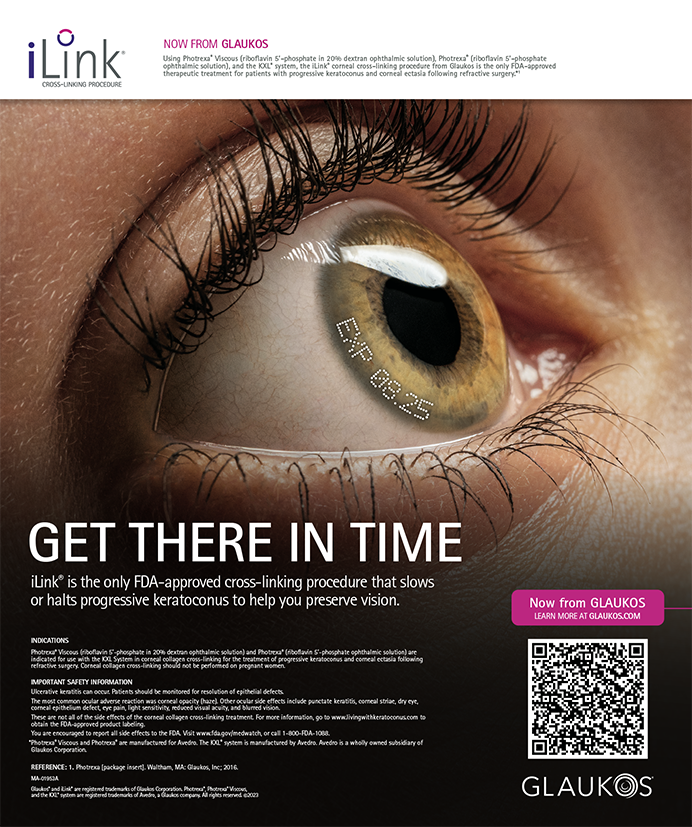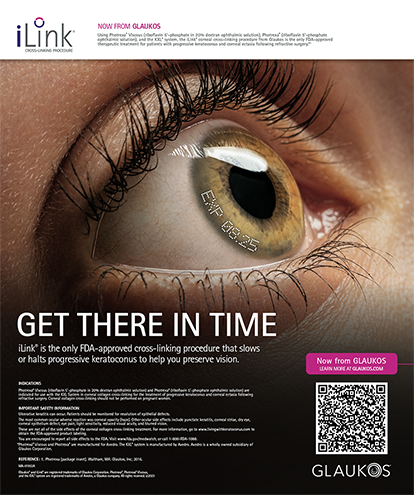
Asking the questions who, what, when, where, why, and how is a good starting point for gathering basic information and solving problems. These questions can form the foundation of understanding a wide range of topics, including dry eye disease (DED), a very large yet vastly underdiagnosed condition.
Most eye doctors struggle with the questions of who needs additional evaluation, what tests to perform, and, perhaps most importantly, how to implement a DED protocol without its being a burden.
THE W’s

Why, Where, When
It is important to recognize and treat DED early, because it is both chronic and progressive. Better long-term outcomes are associated with the initiation of treatment early in the disease course. In the context of patients undergoing eye surgery, abnormalities of the ocular surface and tear film can wreak havoc on postoperative vision, yield refractive surprises, slow healing, and cause discomfort and pain. There is also growing recognition that DED can affect the accuracy of preoperative biometry, topography, keratometry, and, therefore, IOL power calculation and the planning of refractive surgery.
These facts provide a strong rationale for why DED testing is important. Given the prevalence of the condition in the general population, there are likely patients in every ophthalmology practice in need of an evaluation, which answers the question of where to look for them. Because DED is chronic and progressive, the answer to when is as soon as it is feasible.

Who
At my practice, my colleagues and I have four general categories of patients in whom we initiate DED screening, which we view as the first step in identifying patients warranting further evaluation with directed testing:
• all patients undergoing cataract surgery evaluation
• anyone who says that his or her eyes feel dry or gritty, who reports trouble with fluctuating vision, or who says he or she has trouble maintaining visual clarity while using a smart tablet for a prolonged period of time
• women older than 50 years of age, because DED patients can be asymptomatic
• contact lens wearers
Each of these patients is asked key questions derived from the Ocular Surface Disease Index and Standard Patient Evaluation of Eye Dryness questionnaires. We do not administer a full, formal questionnaire, because we found it takes too long (more on the how later). Instead, we have trained staff to listen for symptoms that may indicate DED and a need for further evaluation. Many patients are asymptomatic and may simply report a need to change their glasses because their vision has worsened. That is an unspecific complaint on its own, but in the context of other potential risk factors, it may indicate an ocular surface disorder.
Risk factors are important when identifying DED. A number of classic risk factors have been associated with a higher probability of developing dry eye such as contact lens wear, environment, female sex, menopausal status, medication use, previous ocular or eyelid surgery, diabetes, occupation, autoimmune diseases, age, and diet.1-5 Using a computer, smartphone, and tablet can cause irregular blinking patterns, which can lead to DED. Perhaps for this reason, the overall demographic distribution of the condition is changing. Men are the fastest-growing category of new DED patients, and a not insignificant number of young patients develop dry eye: around 12% of men and 13% of women aged 21 to 34 years have signs and/or symptoms of DED.1

What
After identifying who is in need of further evaluation, we have to determine what diagnostic testing to employ. Evaluating DED is both an art and a science, and advanced diagnostic modalities complement the clinical examination. Listening to the patient and proactively asking questions are as vital a component of understanding the health of a patient’s tear film as the diagnostic platforms that are used.
We routinely use lissamine green staining, which highlights unhealthy areas of the ocular surface. I am particularly interested in three: the lid margin, the bulbar conjunctiva, and the cornea. I score each zone on a scale of zero to four. We also use fluorescein staining and tear breakup time fairly regularly.
Tear osmolarity testing (TearLab) is an important diagnostic instrument for all patients in whom further evaluation is deemed prudent. Abnormal osmolarity is a feature of both aqueous-deficient and evaporative DED. A score of 308 mOsm/L or higher indicates abnormal osmolarity and suggests a need for additional evaluation during the visit and over subsequent visits; fluctuations in the score over time are indicative of the disease and an unhealthy tear film.6 An intereye difference of greater than 8 mOsm/L is also valuable information, because it signals tear film instability.6
Each diagnostic test should be targeted at understanding the etiology of a patient’s DED so that the most appropriate intervention can be initiated. We use the InflammaDry test (RPS), which gives an indication of the presence and activity of matrix metalloproteinase 9 on the ocular surface, because some patients are asymptomatic.
If meibomian gland dysfunction is suspected (ie, evaporative DED), I use the LipiView II Ocular Surface Interferometer (TearScience) to identify any abnormalities. The company’s released dynamic meibomian imaging technology provides remarkable views of the structure and function of the meibomian glands, images that I find extremely useful for educating patients. If meibomian involvement is detected, treatment can be initiated with the LipiFlow Thermal Pulsation System (TearScience). As has been shown in clinical trials, treatment directed at the underlying cause of evaporative DED (ie, at clearing the meibomian glands) helps to restore gland function.7
I have not mentioned the Schirmer test. This is intentional. I find the test to be of little clinical value and burdensome to perform. We use it in clinical trials if it is mandated but not in practice.
If I notice consistently abnormal tear osmolarity results, I will ask the patient about dry mouth and dry nose; in women, I may also ask about vaginal dryness. With these questions, I am attempting to determine if Sjögren syndrome may be present. If it is suspected, I will write a prescription for a venipuncture Sjö blood test (Bausch + Lomb) for the patient to have at a local laboratory.

How
There are many potential diagnostic modalities for evaluating DED, and the prospect of incorporating them into practice can seem daunting. The first thing to realize is that not every patient will need to undergo each test. In fact, the advanced testing in DED is most effective when used selectively to identify the root cause.
Second, technicians can be a valuable resource for conducting the various tests. They are the ones prepping the patient, getting him or her situated, and performing the diagnostics at the start of the examination. That presents a perfect opportunity to ask questions geared toward eliciting visual symptoms that may indicate DED.
In our practice, the technicians screen the patient, ask the initial group of questions, and perform TearLab osmolarity and InflammaDry testing; these two tests have to be done before any eye drops are instilled. My evaluation includes viewing the lissamine green and fluorescein staining, and I may ask more exploratory questions, depending on what I have found from the data to that point.
Adding DED testing to a practice does not have to be burdensome. Although it extends the workup, there are ways to smooth out the process. When we first added osmolarity testing, we had one unit for the entire clinic, which created a bottleneck. Now, we have one unit in each examination room. Results of the InflammaDry test take about 10 minutes to process. Because our technicians administer that test, I am usually walking in the room as the timer is going off and the results are ready for evaluation.
CONCLUSION
Every eye clinic is set up differently, with varied patient populations and objectives. It is my belief that DED is a relevant concern regardless of the practice type. At minimum, patients should be asked questions directed at revealing DED symptoms. I feel that part of the comprehensive eye examination should also account for the health of the ocular surface. The advanced diagnostics available for use in the clinic should be added to the examination only when warranted. Each of these tools for clinical assessment provides a separate piece of the overall picture of the patient’s ocular surface health.
1. Paulsen AJ, Cruickshanks KJ, Fischer ME, et al. Dry eye in the Beaver Dam Offspring Study: prevalence, risk factors, and health-related quality of life. Am J Ophthalmol. 2014;157(4):799-806.
2. The epidemiology of dry eye disease: report of the Epidemiology Subcommittee of the International Dry Eye WorkShop (2007). Ocul Surf. 2007;5(2):93-107.
3. Afsharkhamseh N, Movahedan A, Motahari H, Djalilian AR. Cataract surgery in patients with ocular surface disease: an update in clinical diagnosis and treatment. Saudi J Ophthalmol. 2014;28(3):164-167.
4. The definition and classification of dry eye disease: report of the Definition and Classification Subcommittee of the International Dry Eye WorkShop (2007). Ocul Surf. 2007;5(2):75-92.
5. Schargus M, Wolf F, Tony HP, et al. Correlation between tear film osmolarity, dry eye disease, and rheumatoid arthritis. Cornea. 2014;33(12):1257-1261.
6. Blackie C, Carlson AN, Korb DR. Treatment for meibomian gland dysfunction and dry eye symptoms with a single-dose vectored thermal pulsation: a review. Curr Opin Ophthalmol. 2015;26(4):306-313.
7. Lemp MA, Bron AJ, Baudouin C, et al. Tear osmolarity in the diagnosis and management of dry eye disease. Am J Ophthalmol. 2011;151(5):792-798.
Cynthia Matossian, MD
• owner, founder, and chief medical officer, Matossian Eye Associates, with locations in Pennington and Hamilton, New Jersey, and Doylestown, Pennsylvania
• clinical instructor, Department of Ophthalmology, School of Medicine of Temple University, Philadelphia
• cmatossian@matossianeye.com
• financial disclosure: consultant to RPS and TearLab


